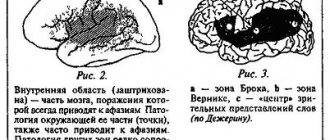Aphasia is a disorder characterized by disruption of previously normal speech. Aphasia can manifest itself to a greater or lesser extent. The person ceases to understand what is said to him and cannot speak himself. The manifestations of this disorder may vary in each case.
- Causes
- Classification of aphasia
- Manifestations of the disorder
- Diagnostics
- Aphasia correction
- Communication Guide
- Prognosis and prevention
Speech symptoms of aphasia:
- paraphasia
- speech emboli
- contamination
- perseveration
- acalculia
- agraphia
- alexia
- logorrhea, etc.
If this disorder is suspected, an examination of function, mental processes and neurological status is necessary. Aphasia is mainly a secondary disorder. That is, it is caused by a certain pathology, the elimination of which also relieves speech symptoms. Training is also necessary to restore speech skills after getting rid of the primary pathology.
Aphasia occurs due to organic damage to the areas of the human brain that are responsible for speech. There is a separate disorder called alalia. Aphasia differs from it in that a person’s speech is initially normal, he can understand phrases addressed to him and normally pronounces what he wants himself. And with alalia, a person cannot form normal speech skills from the very beginning.
Speech impairment in patients with aphasia is characterized as systemic. They are impaired:
- impressive (including understanding and perception),
- expressive (which includes grammar rules, vocabulary, pronunciation of sounds),
- written,
- inner speech.
Also with aphasia the following are affected:
- mental processes
- personality
- motor functions
- sensory sphere
For the reasons described above, aphasia is a complex disorder. It is studied by medical psychologists, speech therapists and neurologists.
Causes
The cause of aphasia is organic damage to the cerebral cortex, namely those areas that have a direct effect on speech. Moreover, for the diagnosis, the individual’s normal speech existing before the onset of the disorder is required. The course and outcome of the disease largely depend on the cause.
Most often the disorder is provoked by vascular diseases of the brain . First of all, these are ischemic stroke and hemorrhagic stroke. With the latter, mainly mixed or total aphasic syndrome is recorded. And sensory or motor aphasia is observed by specialists in those patients who have previously had problems with blood circulation in the brain. The latter are likely to have a total form of aphasia.
The second place among common causes is occupied by inflammatory processes in the brain :
- abscess
- leukoencephalitis
- encephalitis
Also, aphasia in many cases is caused:
- received a traumatic brain injury
- progressive diseases of the central nervous system that occur in a chronic form, for example, Pick's disease
- brain surgery
Risk factors for aphasia:
- presence of the same disorder in close relatives
- old age person
- arterial hypertension
- cerebral atherosclerosis
- head injuries
- past transient ischemic attacks
- rheumatic heart defects
Factors that influence the severity of the disorder:
- extent of the lesion
- location of the affected area of the brain
- compensatory capabilities of the brain
- causes
- premorbid background
- patient's age
For example, the gradual development of speech impairment is observed during tumor processes in the brain. And acute disorders of cerebral circulation, on the contrary, cause a sharp appearance of aphasia. With traumatic brain injury, the development of the disorder is also dramatic. The younger the patient, the faster and better his compensatory mechanisms work; he recovers in a fairly short time after treatment of the underlying disease, the cause of aphasia.
Children will return to normal faster
You should not demand excellent performance in school from your child immediately after overcoming the illness. Even after complete restoration of communication skills, a patient with aphasia may find it difficult to assimilate new information.
The good news is this: in acoustic-mnestic aphasia, the central mechanism does not destroy the brain of young people as significantly as in older people. With an integrated approach that combines drug treatment with physical exercise and other types of restorative therapies, the period of complete recovery is on average five years. However, among young patients in good health, cases of accelerated and sudden relief from the disease are sometimes observed. In addition, in adults, recovery usually remains partial, but in children there is a high chance of full recovery of brain function.
Classification of aphasia
This disorder is classified according to psychological, linguistic and anatomical factors. Today, doctors mainly use the A.R. division. Luria, which is based on the location of the affected area in the dominant hemisphere and the nature of speech disorders. Types of aphasia :
- dynamic
- amnestic-semantic
- acoustic-mnestic
- acoustic-gnostic
- motor (afferent or efferent subtype)
Efferent motor aphasia occurs when the patient's so-called Broca's area is affected. The patient cannot switch from one articulatory position to another, which is called kinetic articulatory apraxia. The afferent subtype of motor aphasia occurs when the lower parts of the postcentral cortex, which is adjacent to the Rolandic sulcus, are affected. This type is characterized by kinesthetic articulatory apraxia.
The amnestic-semantic type of aphasia is caused by damage to the anterior parietal and posterior temporal parts of the cerebral cortex. The patient forgets what names phenomena and objects have. It becomes difficult for him to understand long grammatical structures. He understands simple speech better.
The acoustic-mnestic type of speech disorder is caused by damage to the middle temporal gyrus. The patient's auditory-verbal memory becomes worse or completely disappears. In some cases, there are no visual representations of objects.
When Wernicke's area is affected, an acoustic-gnostic type of aphasia . A person does not understand speech addressed to him, since there is a violation of synthesis, analysis, and phonemic hearing. If the posterior frontal parts of the brain are damaged, dynamic aphasia , in which the patient’s communicative speech function is impaired.
The total form of the disorder in question is recorded when the damage to the cortex of the dominant hemisphere is very extensive. In some cases, mixed types of disorders are recorded.
Can't do it alone
Symptoms of semantic aphasia resemble other language disorders, such as amnestic aphasia, which is much more common. The two main specialists who begin the diagnosis are a neurologist and a speech therapist.
A neurologist determines what kind of brain damage caused the speech disorder. To do this, a complete neurological examination is carried out, reflexes and symmetry of muscle tone are assessed. The doctor checks how the patient navigates space, whether he recognizes objects and sounds, and whether he is able to perform actions upon request.
The speech therapist determines which speech structures are affected. Since the main mechanism of semantic aphasia is the loss of understanding of the meaning of speech patterns and, less often, individual words, the main examination is aimed at finding out how deeply the pathology extends.
Manifestations of the disorder
In a patient with any type of aphasia, speech in general is impaired. A person, when speaking, swaps syllables and individual sounds; literal paraphasias, perseverations, and also contaminations are characteristic. A person begins to make abnormally long pauses between words and phrases. There is hypophonia, that is, a voice similar in volume to a whisper. The rhythm and melody of speech are also impaired in aphasia. If a person develops an efferent motor type of disorder, he pronounces certain sounds normally.
Since reading and writing are impaired in the disorder in question, phenomena such as dysgraphia (the extreme form of which is agraphia) and dyslexia (the extreme form is alexia) are observed. With dysgraphia, a person does not write in capital letters; everything is written urgently. The handwriting of such a person is difficult to understand. He makes many mistakes when writing. Children with this disorder have an extremely difficult time with dictations.
With agraphia, the patient's intellect is preserved, but he cannot write. The cause should be differentiated from hand coordination disorders. With agraphia, a person misses words, cannot combine letters and syllables with each other, and grossly distorts words when writing. Dyslexia to the inability of a person to read, while the patient’s other cognitive abilities are normal.
With afferent motor aphasia, there can be 2 development options. First: there is a speech embolus, there is no spontaneous speech, or articulatory apraxia is recorded. Second: situational speech is normal, but voluntary speech is difficult or completely absent. Secondary processes of hearing impairment are typical for the afferent subtype of motor aphasia. Writing also suffers.
Acoustic-gnostic or sensory aphasia is characterized by the following manifestations:
- normal physical hearing
- impairment of auditory perception of phrases and sentences
Symptoms of Wernicke's aphasia:
- lack of control over one's speech
- not understanding what others say
- compensatory processes in the form of verbosity
- at the beginning of the development of the disease, for one and a half or two months, a person utters spontaneous sets of sounds and words, which is called jargonphasia in the medical literature
- at the beginning of the disease, speech does not make sense to others
- after the stage described above, logorrhea occurs, the person uses verbal and literal paraphasias
- the person may have difficulty writing or may not be able to write at all
- reading skills maintained
Symptoms of acoustic-mnestic aphasia:
- the information heard “does not stay in the brain”
- misunderstanding long phrases
- inability to repeat 3-4 words heard in a row
- a person is unable to speak with two/three or more people at once
- increased speech activity
Amnestic-semantic aphasia has the following symptoms:
- anomia (the patient does not remember the name of this or that object)
- The patient does not understand complex speech patterns or understands them with difficulty
- understanding of cause-and-effect, spatial and temporal verbiage is lost
- a person does not understand words used figuratively, metaphors, etc.
- violation of counting operations
- reading comprehension
Manifestations of dynamic aphasia:
- individual words and phrases are pronounced normally
- repetition is normal
- impossibility of spontaneous narrative speech
- the person doesn't talk much
- perseveration in speech
- echolalia (repetition of phrases spoken by the interlocutor)
- preservation of arithmetic operations, writing and text reading skills
Hidden factor
Semantic aphasia is a subtle disease, it is often disguised as other disorders, and it is quite difficult to detect.
Doctors and teachers were able to describe the disease, observing severe forms, which are extremely rare, and distinguish three stages: 1) mild - it is difficult for the patient to establish cause-and-effect relationships, so he is poor at solving logical problems and cannot find synonyms and antonyms for words;
2) moderately severe - problems arise with counting and mathematical problems, the patient does not understand logical and grammatical constructions, the figurative meaning of words is inaccessible to him, he interprets sayings and proverbs literally;
3) severe - in addition to speech disorders, spatial perception disorders are added, up to confusion when naming parts of one’s own body; grammatical structures, even case endings, are not perceived.
The most common form is mild. The child constructs sentences that are too simple and sometimes makes grammatical errors. He ceases to distinguish parts of speech. If a noun implies an action, such as “walking,” the patient will think of it as a verb. Simple instructions like “point your finger at the table” can be carried out incorrectly or simply not understood.
Diagnostics
Diagnosis of aphasia lies in the competence of speech therapists, neuropsychologists and neurologists. The following studies may be prescribed:
- computed tomography of the brain
- magnetic resonance imaging of the brain
- lumbar puncture
- duplex scanning of cerebral vessels
- Doppler ultrasound of head and neck vessels
- magnetic resonance angiography
The following examinations should be carried out if aphasia is suspected:
- letter diagnostics
- diagnostics of oral speech (impressive and expressive)
- auditory-verbal memory test
- motor memory test
- diagnostics of the state of visual memory
They also carry out diagnostics:
- intelligence
- constructive-spatial activities
- visual gnosis
- praxis (dynamic, somato-spatial, finger, hand, facial, oral)
Differential diagnosis of aphasia with the following diseases is required
- mental retardation
- hearing loss
- dysarthria
- children's alalia
Aphasia correction
The correction includes two components:
- speech therapy
- medical
It is necessary to treat the disease that led to aphasia. Moreover, control should be carried out by a neurosurgeon or an experienced neurologist. Medicines are used for treatment. But sometimes the help of surgeons is also needed. Rehabilitation measures include massage, physiotherapy, mechanical therapy and physical therapy.
To restore normal speech, the patient must attend special speech therapy classes. Correction should be made regarding all components of speech:
- impressive
- expressive
- writing skills
- reading and understanding texts
Treatment for aphasia should begin immediately after injury or stroke, as determined by the attending physician. The sooner treatment is started, the greater the chances of getting rid of pathological symptoms, preventing them from becoming “chronic”. Speech therapy work aimed at restoring normal speech in a patient usually lasts two or three years.
How to recognize?
By a number of signs you can find out that a person is beginning or progressing in the form of aphasia we are considering.
Anomie
Inability to remember the names of objects; the difficulty of “finding the right word.” The affected person may not be able to name the picture of the truck or may substitute another word in the same category, such as “car” instead of “truck.”
Abbreviated understanding of one word
The affected person cannot remember what words mean, especially words that are less familiar or used less frequently. For example, he might ask “What is a truck?”
When the patient is asked to bring an orange, he may return with an apple because the meaning of the word "orange" has been lost. This does not mean that the object is not recognized, as evidenced by the fact that the patient will not attempt to eat an orange without peeling it.
Forgetting familiar objects
Inability to remember what a familiar object is or how it is used. For example, the victim may be unable to identify common kitchen utensils and how they are used in food preparation. This is very unusual in the initial stages of semantic aphasia, but may appear later.
Surface dyslexia/dysgraphia
Difficulty reading and writing words that do not follow the rules of pronunciation or spelling; such words are written or pronounced “as if” they were following rules.
Dyslexic speech disorders
Communication Guide
You can and should communicate with people with aphasia. Patients retain some communicative abilities that need to be activated through communication, without allowing them to “fade away.” Those who suffer from a severe form of aphasia retain the ability to understand the meaning of what is said (although not every word individually). Often the patient may not understand what is being said to him because he does not remember the meaning of individual words or forgets the beginning of a phrase.
How to communicate with people with aphasia:
- sit down and catch the person's eye
- if you are afraid of communication, you should start with simple topics, for example, tell how your day was in the simplest terms, then you need to ask a simple question
- It’s better to speak at a slow pace, focusing your voice on key words in the text
- You can do the following practice: write down the key words of the future conversation on paper, then repeat what was said and show the paper to the patient. This will be his cue for conversation.
- use not only the spoken word to communicate, but also writing, drawings, gestures, and pointing at objects. Forgive a person to do the same, let him use a dictionary if it will be easier to communicate
- if the patient is trying to convey some idea to you, determine who he is talking about, what exactly happened and in what place
- it is important to be able to ask leading questions
- do not ask questions that require monosyllabic answers
- be patient, because communication with a person with aphasia is far from easy, but it is necessary
When to sound the alarm?
It is necessary to sound the alarm and conduct a thorough diagnostic examination when observing the following three indicators if:
There is a gradual deterioration of language (not just speech). The language problem is initially the only deficiency. The main cause is a neurodegenerative disease.
A distinctive feature of the semantic variant of aphasia is the progressive loss of word meanings. If there are additional severe problems in identifying objects or persons, the condition is also called semantic dementia.
Other language skills, including the ability to produce speech and repeat phrases and sentences spoken by others, are not affected. However, although the affected person may continue to speak freely, their speech becomes unclear and difficult to understand because many words are omitted or replaced.
Language problems increase over time. There is a slow but progressive loss of vocabulary and the ability to understand what people say. Speech becomes increasingly vague and the amount of speech tends to decrease.
In the future, non-linguistic functions are disrupted during the disease. In particular, a person may find it increasingly difficult to recognize familiar people or household objects. Problems associated with carrying out normal daily activities are also increasing.
Prognosis and prevention
Speech therapy correction of this disorder takes a lot of time. Not only the doctor, but also the speech therapist and the patient’s relatives should take part in it. The earlier treatment is started, the greater the chances of success. How much the patient’s speech will be restored depends on the size and location of the affected area in the brain, age and other factors that were described above.
Most often, young patients recover. But, if this diagnosis was made to a 5-7 year old child, then speech may be completely lost, or the prognosis is a severe violation of speech development. Motor aphasia can end spontaneously in patients of any age, turning into stuttering.
Preventive measures include timely diagnosis of brain tumors and their adequate treatment; in the prevention of traumatic brain injuries, in the prevention of cerebrovascular accidents.
Treatment approaches
Effective therapy is based on eliminating the immediate cause of the development of speech disorder. If a tumor lesion or intracranial hematoma is detected, treatment is carried out with neurosurgery, radiation or chemotherapy. Neuroinfections are eliminated using antifungal, antibacterial or antiviral drugs. Strokes are subject to thrombolytic or hemostatic treatment.
Correction of speech disorders is based on:
- Regular speech therapy sessions
They are carried out to increase the volume of auditory-verbal memory. They must be started immediately after the onset of the disease, without delaying a visit to a speech therapist for the rehabilitation period. Initially, exercises with visual perception of an object are used, which makes them easier to remember. Next, the specialist complicates the lessons - the patient writes simple dictations by ear, learns fragments of sentences, word chains, songs and poems. To improve expressive speech, active work is being carried out to clarify the meaning of words and systematize them into separate groups.
In parallel with the treatment of the main pathology, rehabilitation measures begin with the patient. An important part of therapy is communication with medical staff, speech therapist and loved ones. As a result of constant verbal contact and speech therapy exercises, auditory-verbal memory is restored. In addition, patients are advised to exercise therapy, massage and visit a psychotherapist.






